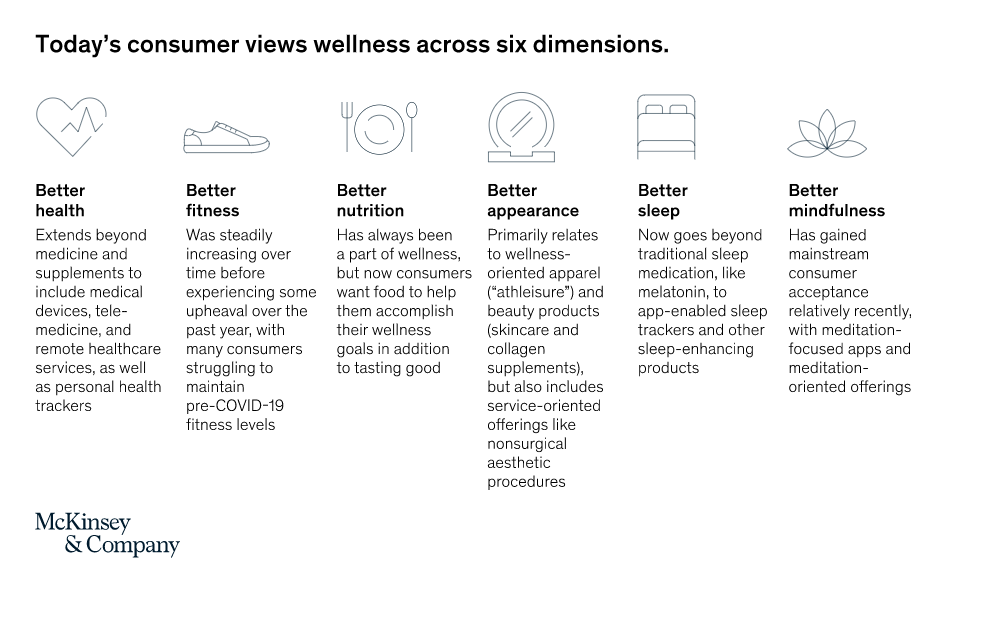The Future of Wellness
In this Snapshot blog post we explore the rapidly changing, rapidly growing wellness industry. How is the Health and Wellness sector adapting to thrive in the current landscape?
Let's explore 'The Future of Wellness'.

The growth of the wellness economy has now increased its global market value to approximately 4.4 trillion – with an annual growth rate of 5 to 10 per cent in recent years. The U.S. has the most significant health and wellness market, with China and Australia following. Additionally, the UK is also a massive contender, at an enormous 9 billion.
Post pandemic, consumers have increased spending on products and services that improve their health, fitness, appearance, sleep, and mindfulness.
Over the past few decades, mental health has gone from being a relatively ignored or 'taboo' issue to being openly discussed. As a result, psychological and physical health is now at the forefront of most marketing campaigns.
Gyms and wellness centres are adapting to meet the changing consumer needs by diversifying their offerings.

What are todays' health and fitness enthusiasts looking for ?
Fitness customer practices have advanced considerably during the COVID-19 pandemic. Now offering the fitness-industry providers an opportunity to reassess their value propositions and target specific segments.
These segments range from mental wellbeing apps to the explosion of wellness practises like yoga classes. Furthermore, workplace schemes aimed at caring for employees' psychological and physical health have also been created.
As a result, mental and physical fitness has expanded into practically every aspect of modern life. Fitness consumers continue using various services, tools, and solutions to help them look, feel, and function better.
According to a recent survey done by McKinsey & Company, today's consumer views wellness across the below six dimensions.

The six categories mentioned above were necessary for consumers across the McKinsey surveyed countries. In addition, they indicated that better health consistently appears as the most crucial wellness dimension (noted as the one with the highest level of spending) across every market they researched.
McKinsey notes that, at the same time, relative responses vary in other categories. For example, consumers in Japan prioritise appearance while those in Germany emphasise fitness; respondents in Brazil and the United States are most interested in mindfulness, and those in China and the United Kingdom in nutrition.
How can the Health & Wellness sector adapt and thrive in the current landscape?
Research shows that the future of wellness will be more personalised, tech-focused and interconnected. So, what can health and wellness companies do to be more successful going forwards?
Have a holistic approach towards your customers needs
With consumers being more aware of their mental, physical and spiritual well-being, companies need to start viewing their customers/members holistically. What would benefit my customers' entire well-being? How can I make the experience more appealing in its entirety?
Gyms and wellness studios should aim to develop communities to help meet their consumers’ psychological need for belonging. Providing a mutual support alongside their physical needs.
Make sure to assess your digital strategy
With consumers utilising technology as an integrated part of their daily lives, it’s crucial to consider your digital strategy broadly.
For example, are you set up for e-commerce when looking at your sales channel? Are you utilising social media and the power of influencers in your social media and marketing efforts?
Make personalisation key in your approach
Today's consumers are more inclined to give their data to get personalised treatment and service now than ever before.
The channels seeing the most request for personalisation includes; fitness, mindfulness, sleep and health. Companies who can curate their offering to make it more personalised will appeal to today's consumers - In the process, gaining valuable data insights from the service.
Engage in data partnerships
The COVID-19 pandemic provides us with a great example of just how relevant external data can be. Consumer purchasing habits, activities, and digital behaviour changed drastically in just a few short months. This sudden change has made companies reevaluate their data strategies considerably.
Data is going to be a key commodity going forwards. Having a way to tie these different data systems together is probably the best secret.
Make shopping exciting
In future, the concept of shopping will change drastically. We have already seen glimpses of this through hyperphysical spaces that have recently started to appear in the retail industry. Capturing the concept of discovery and sensory excitement - whether through services, classes, or just a curated experience.
Update your value proposition
Understand how your value proposition might have changed. For example, if you own a gym and you realise that people have more diverse fitness routines, you need to ask yourself - “How do I make sure I am one of the solutions of today?”
To conclude
As you would have guessed, wellness is here to stay! With consumers globally planning to increase their spending on personal health, appearance, and fitness going forwards.
For the health and wellness enthusiast, you can expect a more tailored experience that considers all your needs—being able to monitor physical and mental health much more accurately. Additionally, experiences will also become a lot more Virtual and technologically enhanced.
If you're in the health and wellness sector - you will need to not only keep up to date with fitness trends but make sure to incorporate a mindfulness approach as well. In addition, keep an eye on technological developments, and make sure to include what is possible in your experience.
If the pandemic has taught us one thing, it’s that physical and mental health will remain a priority for a long time to come.
Share this blog with your community to keep them informed.


